In this activity you will be able
to use readily available materials to demonstrate and thereby better
understand the concept of light
scattering. It is a reasonably important topic because we are
able
to see clouds, fog, and haze because the small drops of water, ice
crystals, and particles are able to
intercept and scatter sunlight.
For the demonstration fill a clear glass with water. After allowing the water to sit for a few minutes, gently free any bubbles that may be stuck to the sides of the glass. Then shine a bright narrow beam of light sideways through the glass. A laser pointer is an ideal light source but a bright narrow beam flashlight should also work.
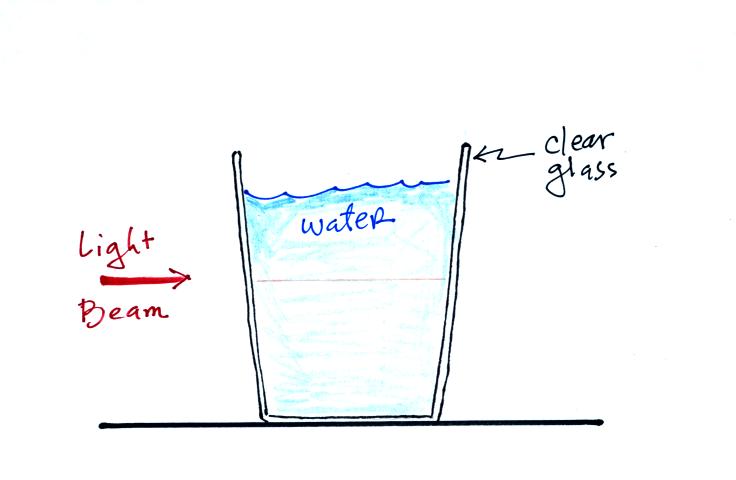
To see the beam, you must look back toward the light source. You would see the beam if you put your head in position A in the figure above and looked back toward the light source (you shouldn't do this with a laser pointer because the light source might be intense enough to damage your eye). You will probably be able to clearly see the light beam if you put your head at Position B in the figure above (i.e. a little bit above the light beam but still looking back toward the light source. The beam in this case might appear curved and probably you will just see a segment of light where the beam is traveling through the water.
Now what we will do is to add a few drops of milk to the water in the glass. Add just enough to just begin to cloud the water. The beam should now be clearly visible as it passes through the water/milk mixture (but still not visible in the air alongside the glass). A portion of the light in the original beam is intercepted by small particles of milk fat and the light is redirected in all directions (up, down, to the right and left as shown in the picture below but also toward and away from the observer). This is scattering of light. A more descriptive term might be splattering of light. One of those scattered rays of light is directed straight at you, and that is why you are able to see the beam of light passing through the water.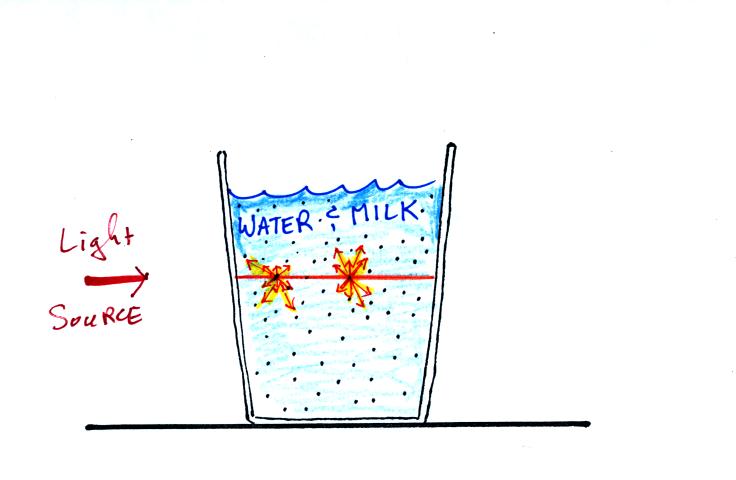
Scattering is only shown at two points in the figure above, but
actually it is occuring along the entire length of the beam. The
scattered light is much weaker than the
light in the original beam. It is safe to look at scattered light.
Next we will add more milk to the water in the glass. At some point you should begin to see the intensity of the beam decrease as it moves from left to right. As light is scattered it is removed from the original beam. The unscattered beam of light weakens as it moves through the water.
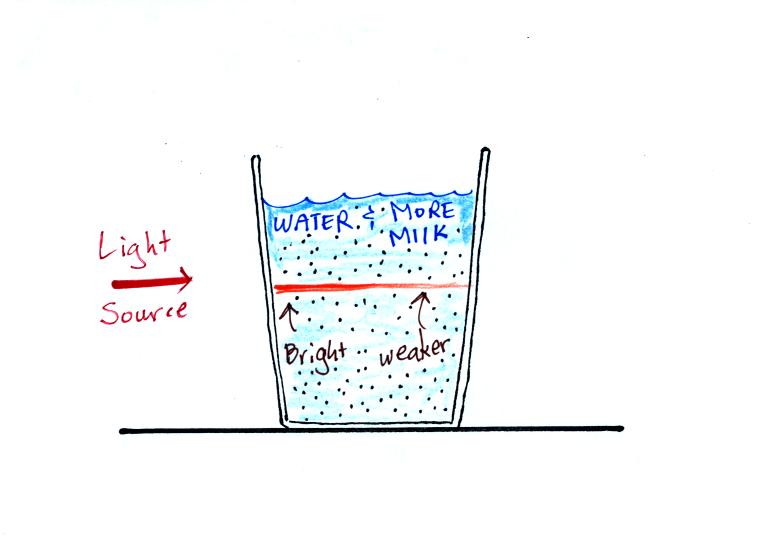
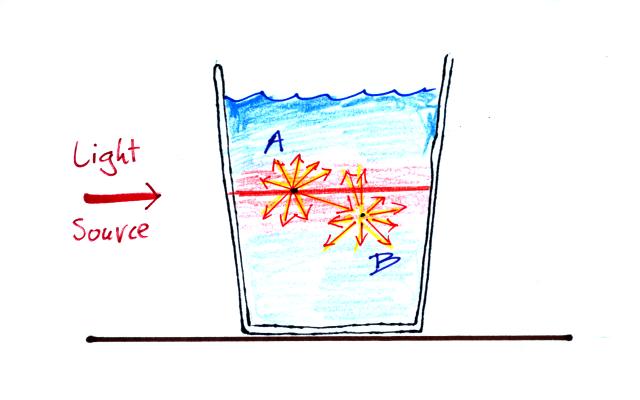
For the demonstration fill a clear glass with water. After allowing the water to sit for a few minutes, gently free any bubbles that may be stuck to the sides of the glass. Then shine a bright narrow beam of light sideways through the glass. A laser pointer is an ideal light source but a bright narrow beam flashlight should also work.

If the light source is bright
enough, you may be able to see the beam as it travels through the water
(this is shown with a faint line in the figure above). You won't
be able to see the light beam as is travels through the air outside the
glass.
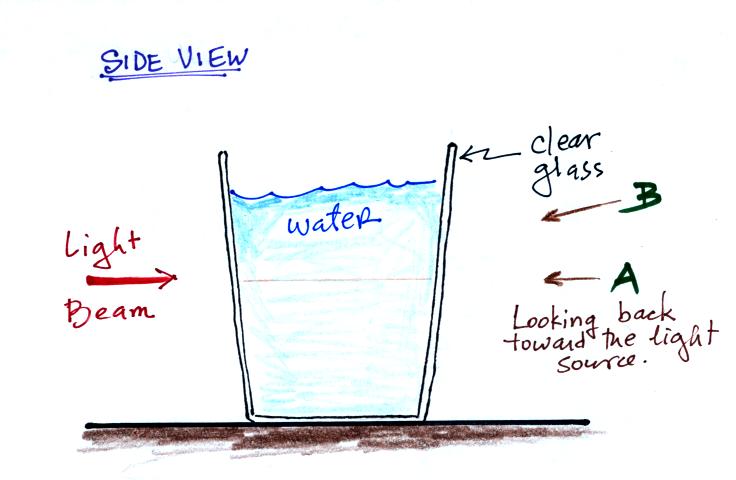

To see the beam, you must look back toward the light source. You would see the beam if you put your head in position A in the figure above and looked back toward the light source (you shouldn't do this with a laser pointer because the light source might be intense enough to damage your eye). You will probably be able to clearly see the light beam if you put your head at Position B in the figure above (i.e. a little bit above the light beam but still looking back toward the light source. The beam in this case might appear curved and probably you will just see a segment of light where the beam is traveling through the water.
Now what we will do is to add a few drops of milk to the water in the glass. Add just enough to just begin to cloud the water. The beam should now be clearly visible as it passes through the water/milk mixture (but still not visible in the air alongside the glass). A portion of the light in the original beam is intercepted by small particles of milk fat and the light is redirected in all directions (up, down, to the right and left as shown in the picture below but also toward and away from the observer). This is scattering of light. A more descriptive term might be splattering of light. One of those scattered rays of light is directed straight at you, and that is why you are able to see the beam of light passing through the water.

Next we will add more milk to the water in the glass. At some point you should begin to see the intensity of the beam decrease as it moves from left to right. As light is scattered it is removed from the original beam. The unscattered beam of light weakens as it moves through the water.

Sunlight reaching the ground when
the sun is high in the sky is usually much more intense than sunlight
arriving at the ground when the sun is near the horizon. Sunlight
must follow a much longer path through the atmosphere when it is low in
the sky. Scattering occurs all along this long path with the
result that the sunlight reaching the ground has been attenuated
significantly. Of course you shouldn't look directly
at the sun even when it is on or near the horizon. Even though
the sunlight is much weaker than when the sun is high in the sky, it is
still intense enough to damage your eyes.
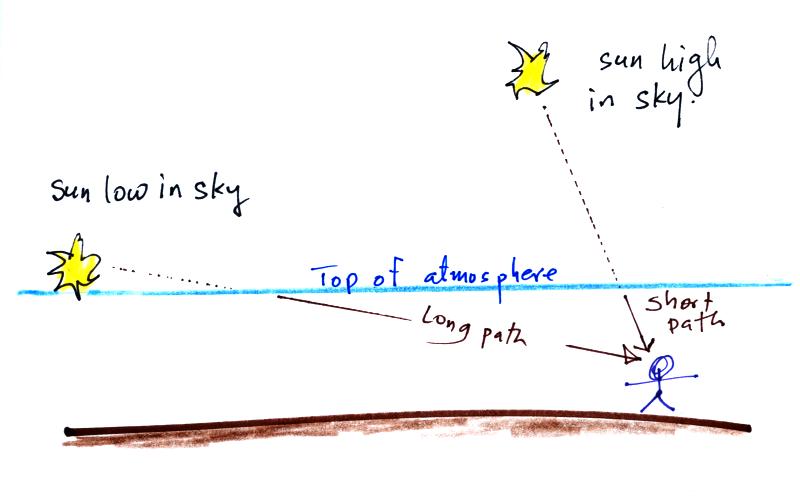

Once you have added more milk to
the water in the glass you may notice scattered light coming from
outside the beam. At Point A in the figure below light is being
scattered by milk particles in the beam. This is single
scattering and is
what we have been observing up to this point. Some of the light
scattered by particles in the beam may be intercepted and scattered by
another milk particle that is outside the beam. This situation is
shown at Point B. This is called multiple scattering.
